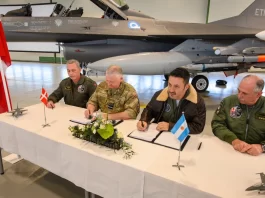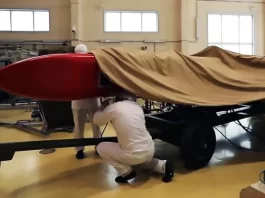A ceremony took place on July 16, 2024, at the Chiang Mai airbase in Thailand to officially introduce the Royal Thai Air Force (RTAF) to the first two light turboprop combat (attack) aircraft, the Beechcraft AT-6TH Wolverine, which are manufactured by the US company Textron. These are the initial eight aircraft that were procured pursuant to a 2021 contract. The aircraft, which possesses Thai registration numbers “41101” and “41102,” has been assigned to the 411th Squadron of the 41st Wing of the RTAF, which is situated in Chiang Mai. Consequently, Thailand became the first serial operator of the AT-6 Wolverine, a combat version of the well-known Beechcraft T-6 Texan II turboprop training aircraft.
The RTAF executed a contract with Textron Aviation (Textron’s aircraft manufacturing division) in November 2021 to acquire eight AT-6TH Wolverine aircraft, including personnel training and technical support, for a total of about 143 million USD. The first two aircraft under this contract were produced in the US in 2023 and shipped to Thailand in May 2024. They were subsequently assembled at the state-owned aircraft repair enterprise Thai Aviation Industries (TAI) in Takhli, Nakhon Sawan province. It is anticipated that Thailand will receive the remaining six AT-6TH aircraft by the end of the year. Previously, it was reported that the contract option included an additional four AT-6TH aircraft. However, no information is available regarding the negotiations regarding the order for the additional four aircraft.

The AT-6TH aircraft will replace the Czech-made L-39ZA/ART aircraft, which was decommissioned in 2021 after being used as a light attack aircraft, in the 411th Squadron of the 41st Wing of the RTAF. At the Royal Thai Air Force Academy in Saraburi, the RTAF currently operates 12 Beechcraft T-6TH Texan II training aircraft, which were acquired in 2022-2023 and are utilized for the primary stage of flight training.
The AT-6 Wolverine, also known as the AT-6B and AT-6E is a licensed variant of the Swiss Pilatus PC-9 aircraft and an attack version of the Beechcraft T-6 Texan II turboprop trainer aircraft currently in service with the US Air Force. Textron Aviation initially developed it as a proposal for the US Air Force’s potential light combat aircraft OA-X program. In 2009, the OA-X program (originally known as Light Attack/Armed Reconnaissance – LAAR) was initiated to use light turboprop attack aircraft as a potential “low-cost” alternative to the use of “real” combat aircraft, including A-10 attack aircraft, in low and medium-intensity conflicts. The program initially aimed to acquire 100 to 300 light combat aircraft.
The AT-6B and the Brazilian turboprop trainer-combat aircraft Embraer A-29B (EMB-314) Super Tucano, which were promoted by American company Sierra Nevada Corporation (SNC), were chosen by the US Air Force as finalists for the OA-X tender in early 2018. SNC had arranged for the Super Tucano to be assembled from kit components in the US at a joint venture with Embraer in Jacksonville, Florida, for deliveries to “partners” under US military aid. Nevertheless, the funding for the OA-X program was terminated in 2021, and the US Air Force progressively lost interest in it. The program ultimately “deflated” by the end of 2019. Nevertheless, the US Air Force decided in October 2019 to order two AT-6B (AT-6E) and two A-29B aircraft for comparative testing under the “Light Attack Experiment” (LAE). The orders were issued in March 2020. Textron Aviation was awarded a $70.2 million contract to deliver two AT-6E Wolverine aircraft in 2021.
The comparative evaluations of the AT-6E and A-29B aircraft that were bought were never conducted due to the program’s termination. It was reported that the Air Combat Command at Nellis Air Force Base was planning on using both AT-6E Wolverine aircraft received by the US Air Force to conduct tests on the AERONet (Airborne Extensible Relay Over-Horizon Network), an advanced airborne target designation and data transmission system that is intended for delivery to US allies and “partners.” Nevertheless, there is no information regarding the AT-6E’s genuine uses within the US Air Force.
The AT-6 Wolverine is equipped with six underwing hardpoints for weapons and a more powerful Pratt & Whitney Canada PT6-68D turboprop engine, which has a takeoff capacity of 1600 hp, in comparison to the base T-6 Texan II. It is equipped with a laser rangefinder designator and a WESCAM MX-15D electro-optical station located beneath the fuselage. The aircraft is equipped with AERONet equipment, an Iridium satellite communication station, an advanced protected inertial-satellite navigation system, a video transmission system for forward air controllers (ROVER), and military satellite communication equipment. It is reported that the aircraft will be capable of transporting a variety of unguided armaments, Hellfire guided missiles, 70-mm APKWS guided rockets, and GBU-12 Paveway II guided bombs in the configuration designated for the RTAF.
The US Defense Security Cooperation Agency (DSCA) informed Congress in February 2020 that it was considering the transfer of four AT-6C Wolverine aircraft to Tunisia under the US Foreign Military Sales (FMS) program. Nevertheless, this delivery was not executed, and Thailand became the first operator of the Wolverine aircraft in service.





